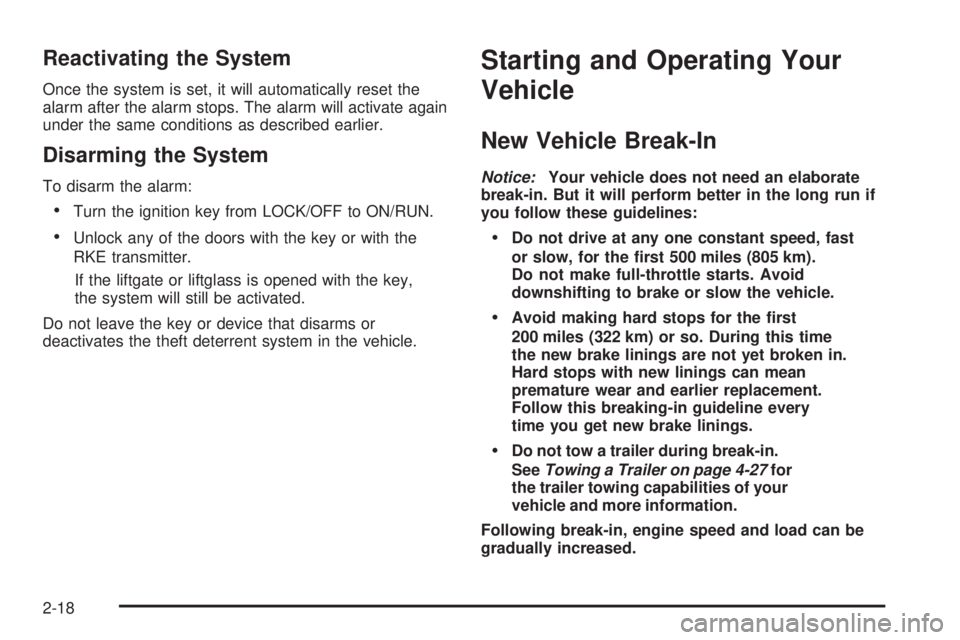alarm PONTIAC VIBE 2008 Owners Manual
[x] Cancel search | Manufacturer: PONTIAC, Model Year: 2008, Model line: VIBE, Model: PONTIAC VIBE 2008Pages: 368, PDF Size: 5.7 MB
Page 88 of 368

Do not leave the key or device that disarms
or deactivates the theft deterrent system in
the vehicle.
Content Theft-Deterrent
Your vehicle may have a theft-deterrent system
designed to activate an alarm if someone attempts to
damage or break into your vehicle. The alarm will sound
and the headlamps and turn signal lamps will �ash for
about one minute. The interior lights will also come on
when the interior lamps control is in the door position.
Your vehicle will have one of the following security
lights, located on the instrument panel to the left of
the steering wheel.
Arming the System
To arm the system:
1. Remove the key from the ignition.
The security light will �ash when the key is removed
from the ignition. SeeImmobilizer Operation (Canada
Only) on page 2-15for additional information.
2. Have all passengers get out of the vehicle.
3. Close and lock all doors including the liftgate/liftglass
with the key or Remote Keyless Entry (RKE)
transmitter.
The security light will come on when all doors and
liftgate are closed and locked.
The system will be automatically set after
30 seconds. When the system is set, the
security light will �ash.
4. After the security light starts �ashing, you may
leave the vehicle.
Do not leave anyone in the vehicle when you set
the system, because unlocking the vehicle from the
inside will activate the system.
2-16
Page 89 of 368

Testing the Alarm
To test the alarm:
1. Open all the windows.
2. Set the system as described in the previous
procedure. The doors and liftgate should be locked
with the key or RKE transmitter. Be sure to wait
until the security light starts �ashing.
3. Unlock the driver’s door from the inside.
The system should activate the alarm.
4. Stop the alarm as described in the disarming
procedure following.
5. Repeat this operation for the other doors.
Also check that the system is activated when
the battery terminal is disconnected and then
reconnected.
If the system does not work properly, have it
checked by your dealer/retailer.
How the System Alarm is Activated
The system will activate the alarm:
If the driver’s or front passenger’s door is unlocked
without using the key or RKE transmitter.
If any door or the liftgate/liftglass is forcibly opened
without the key or RKE transmitter.
If the battery terminal is disconnected and then
reconnected.
If the ignition is hot-wired.
If the side window glass is broken or damaged.
The security light will come on when the system
is activated.
If the driver’s or front passenger’s doors are unlocked
without using the key or RKE transmitter, the other doors
and the liftgate will be automatically locked again.
After one minute the alarm will automatically stop and
the security light will start �ashing again.
2-17
Page 90 of 368

Reactivating the System
Once the system is set, it will automatically reset the
alarm after the alarm stops. The alarm will activate again
under the same conditions as described earlier.
Disarming the System
To disarm the alarm:
Turn the ignition key from LOCK/OFF to ON/RUN.
Unlock any of the doors with the key or with the
RKE transmitter.
If the liftgate or liftglass is opened with the key,
the system will still be activated.
Do not leave the key or device that disarms or
deactivates the theft deterrent system in the vehicle.
Starting and Operating Your
Vehicle
New Vehicle Break-In
Notice:Your vehicle does not need an elaborate
break-in. But it will perform better in the long run if
you follow these guidelines:
Do not drive at any one constant speed, fast
or slow, for the �rst 500 miles (805 km).
Do not make full-throttle starts. Avoid
downshifting to brake or slow the vehicle.
Avoid making hard stops for the �rst
200 miles (322 km) or so. During this time
the new brake linings are not yet broken in.
Hard stops with new linings can mean
premature wear and earlier replacement.
Follow this breaking-in guideline every
time you get new brake linings.
Do not tow a trailer during break-in.
SeeTowing a Trailer on page 4-27for
the trailer towing capabilities of your
vehicle and more information.
Following break-in, engine speed and load can be
gradually increased.
2-18
Page 141 of 368

Warning Lights, Gages, and
Indicators
This section describes the warning lights and gages on
your vehicle.
Warning lights and gages can signal that something
is wrong before it becomes serious enough to cause an
expensive repair or replacement. Paying attention to
the warning lights and gages could also save you
or others from injury.
Warning lights come on when there may be or is a
problem with one of your vehicle’s functions. As the
details show on the next few pages, some warning lights
come on brie�y when you start the engine just to let
you know they are working. If you are familiar with this
section, you should not be alarmed when this happens.Gages can indicate when there may be or is a problem
with one of your vehicle’s functions. Often gages
and warning lights work together to let you know
when there is a problem with your vehicle.
When one of the warning lights comes on and stays
on as you are driving, or when one of the gages shows
there may be a problem, check the section that tells
you what to do about it. Please follow this manual’s
advice. Waiting to do repairs can be costly and even
dangerous. So get to know your vehicle’s warning lights
and gages. They can be a big help.
3-25
Page 187 of 368

StabiliTrak®System
Your vehicle may have this feature. The StabiliTrak®
system helps provide integrated control of the systems
such as anti-lock brake system, traction control and
engine control. This system automatically controls the
brakes and engine to help prevent the vehicle from
skidding when cornering on a slippery road surface
or turning the steering wheel abruptly.
This system will activate when your vehicle speed
reaches or exceeds 9 mph (15 km/h), and will
deactivate when the vehicle speed reduces to
below 9 mph (15 km/h).
You may hear a sound in the engine compartment for a
few seconds when the engine is started or just after the
vehicle begins to move. This means that the system is in
the self-check mode, but does not indicate a malfunction.
If the vehicle is going to skid during driving, the traction
control system warning light will blink and an alarm
will sound intermittently. Adjust your driving accordingly.
This light warns that there
is a problem somewhere
in the traction control
system or StabiliTrak
®.
Panic Brake Assist
Your vehicle has a panic brake assist system that
monitors the intention of the driver while braking. If the
system senses that the driver has applied hard/fast
pressure to the brake pedal, the system will generate
additional pressure, making it easier for the driver to
maintain brake application. When this happens the brake
pedal will feel easier to push. Just hold the brake pedal
down �rmly and let the system work for you. You may feel
the brakes vibrate, or you may notice some noise but this
is normal. The brakes will return to normal operation after
the brake pedal has been released.
The brake assist system becomes operational after
the vehicle has accelerated to a speed in excess
of approximately 6 mph (10 km/h). It stops operating
when the vehicle decelerates to a speed below
approximately 3 mph (5 km/h).
4-7